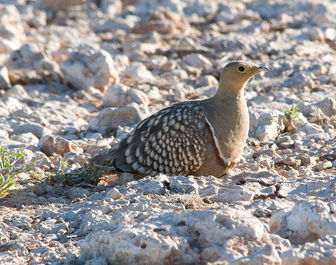Namaqua Sandgrouse

Original source: derivative work: Snowmanradio (talk)
Author: derivative work: Snowmanradio (talk)
The Namaqua Sandgrouse is classified as Least Concern. Does not qualify for a more at risk category. Widespread and abundant taxa are included in this category.
The Namaqua Sandgrouse (Pterocles namaqua) is a species of bird in the Pteroclididae family. It is found in Angola, Botswana, Lesotho, Namibia, South Africa, and Zimbabwe. References - * BirdLife International 2004. Pterocles namaqua. 2006 IUCN Red List of Threatened Species. Downloaded on 24 July 2007. More
The Namaqua sandgrouse, Pterocles namaqua, is a highly nomadic granivore of semiarid to arid habitats. As a result of nomadic movements in response to rainfall, the size of the breeding population in any one area fluctuates dramatically between breeding seasons. This high mobility in response to spatial and temporal abundance of food resources is expected to result in little population genetic structuring. More
For example, the Namaqua Sandgrouse is described as “nomadic; southern populations partially migratory…” The Namaqua Sandgrouse is regarded as showing regular east-west movements related to breeding within northern South Africa and Botswana whilst being more sedentary in Namibia. Yet these movements were not revealed by the series of detailed two-monthly maps of this species as shown in the Atlas of Southern African Birds based on data collected over a decade. More
Distribution of Namaqua sandgrouse in southern Africa, based on statistical smoothing of the records from first SA Bird Atlas Project (© Animal Demography unit, University of Cape Town; smoothing by Birgit Erni and Francesca Little). Colours range from dark blue (most common) through to yellow (least common). See here for the latest distribution from the SABAP2. Contact us if you can contribute information or images to improve this page. More
In spite of its name, the Namaqua sandgrouse is not restricted to the Namaqualand area in South Africa, but can be found all over the western half of southern Africa and particularly in arid areas with short grass. They are mostly seen at a waterhole in the Kalahari or Namib Desert where it announces its presence with the characteristic, melancholy kelkiewyn call. The male has a rusty brown breast with a breast bar, while the female has a yellowish throat and v-markings on her chest. More
The Namaqua Sandgrouse is endemic to SW Africa where it is the only sandgrouse with a long pointed tail. It can usually be seen coming to drink at waterholes in the morning. We found many of these birds at Etosha. IMG_2731b.jpg IMG_2735b.jpg IMG_2736b.jpg IMG_2737b.jpg IMG_2898b. More
The Namaqua Sandgrouse is found from the extreme south western Angola to Namibia, Botswana and western South Africa. From the West Coast to the Eastern Free State and Eastern Cape interior and as far south as the wheat-lands of the south western Cape. It is a vagrant to Zimbabwe, Lesotho lowlands, KwaZulu Natal and Eastern Cape seaboard. Their movements are Nomadic. Southern populations are partially migratory, especially in the Karoo. More
Family : Pteroclididae
Genus : Pterocles
Species : namaqua
Authority : (Gmelin, 1789)

